Analysis of Customer Experience Management at Intercontinental Hotel
VerifiedAdded on 2023/01/17
|10
|2172
|37
Report
AI Summary
This report provides a comprehensive analysis of customer experience management, focusing on the Intercontinental Hotel. The introduction sets the stage by defining customer experience management and its significance in the hospitality industry. Task 1 delves into the value of understanding customer needs and wants, emphasizing the importance of tailoring services to meet specific market segments. It explores factors that drive customer engagement, considering technological, social, and privacy factors. Task 2 presents a customer experience map, illustrating the customer journey from arrival to bill payment, and identifies key customer touchpoints. The report concludes by summarizing the findings and highlighting the importance of customer-centric strategies. The report uses references to support the analysis and recommendations. The report underscores the significance of customer experience management for building customer loyalty and enhancing business success.
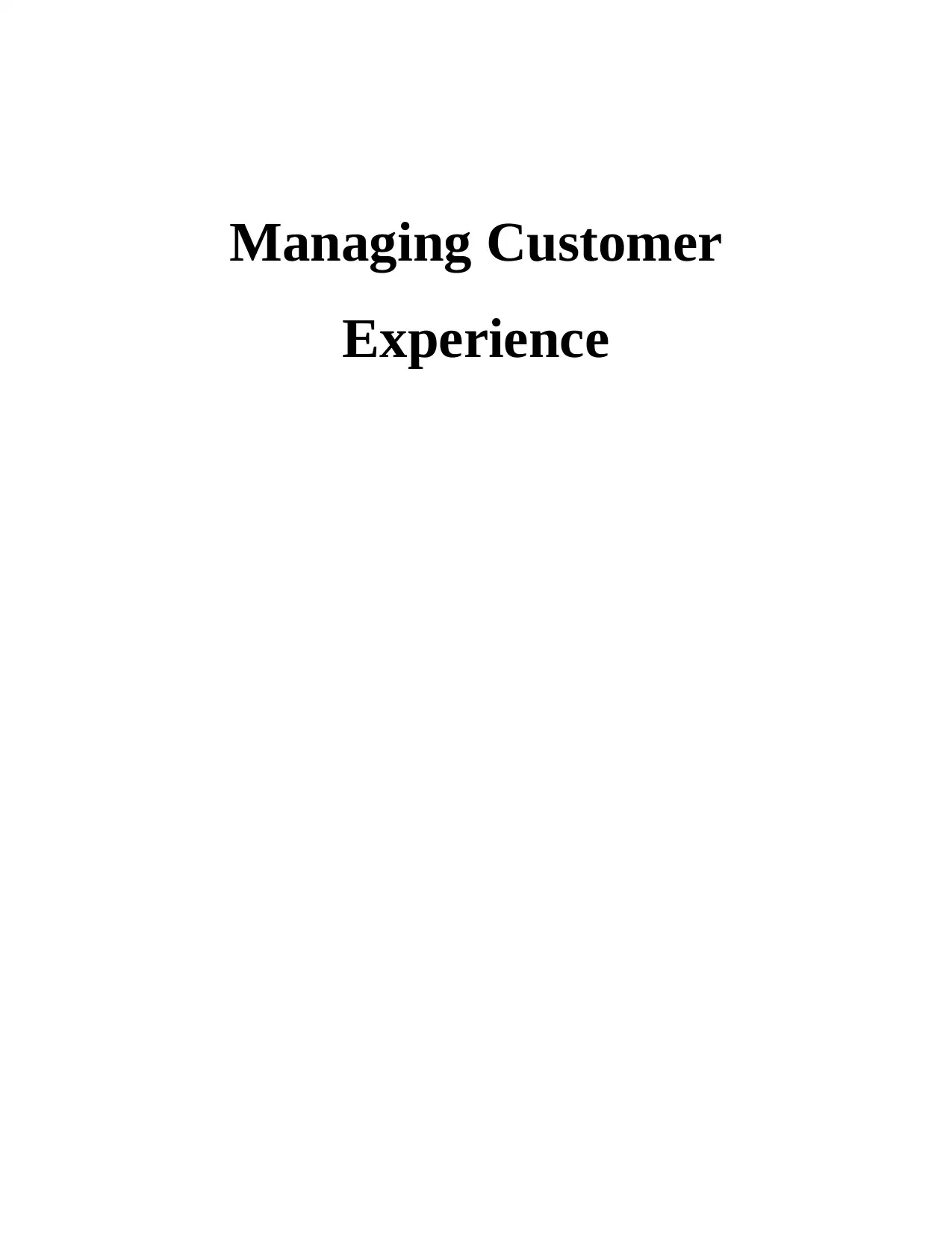
Managing Customer
Experience
Experience
Paraphrase This Document
Need a fresh take? Get an instant paraphrase of this document with our AI Paraphraser
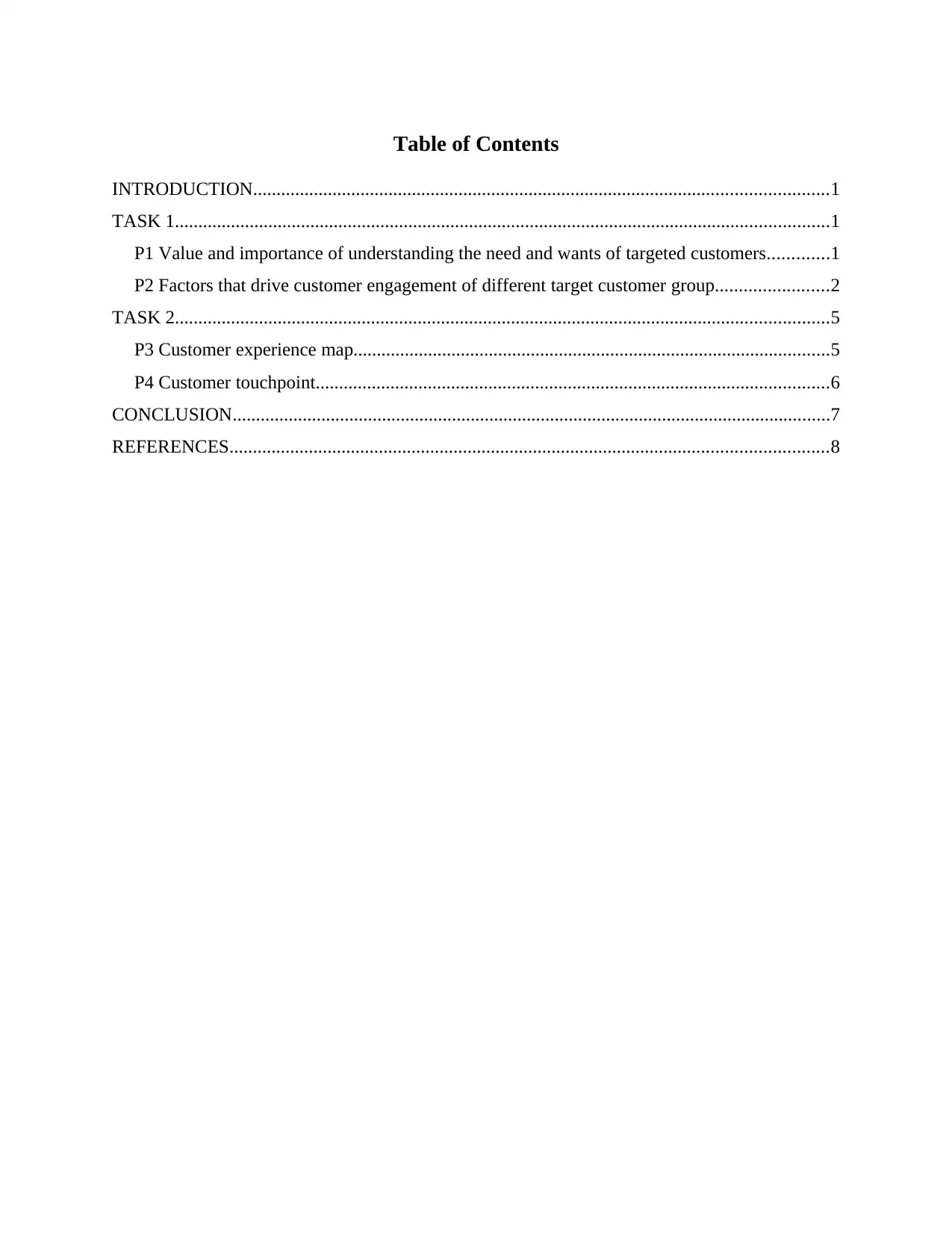
Table of Contents
INTRODUCTION...........................................................................................................................1
TASK 1............................................................................................................................................1
P1 Value and importance of understanding the need and wants of targeted customers.............1
P2 Factors that drive customer engagement of different target customer group........................2
TASK 2............................................................................................................................................5
P3 Customer experience map......................................................................................................5
P4 Customer touchpoint..............................................................................................................6
CONCLUSION................................................................................................................................7
REFERENCES................................................................................................................................8
INTRODUCTION...........................................................................................................................1
TASK 1............................................................................................................................................1
P1 Value and importance of understanding the need and wants of targeted customers.............1
P2 Factors that drive customer engagement of different target customer group........................2
TASK 2............................................................................................................................................5
P3 Customer experience map......................................................................................................5
P4 Customer touchpoint..............................................................................................................6
CONCLUSION................................................................................................................................7
REFERENCES................................................................................................................................8
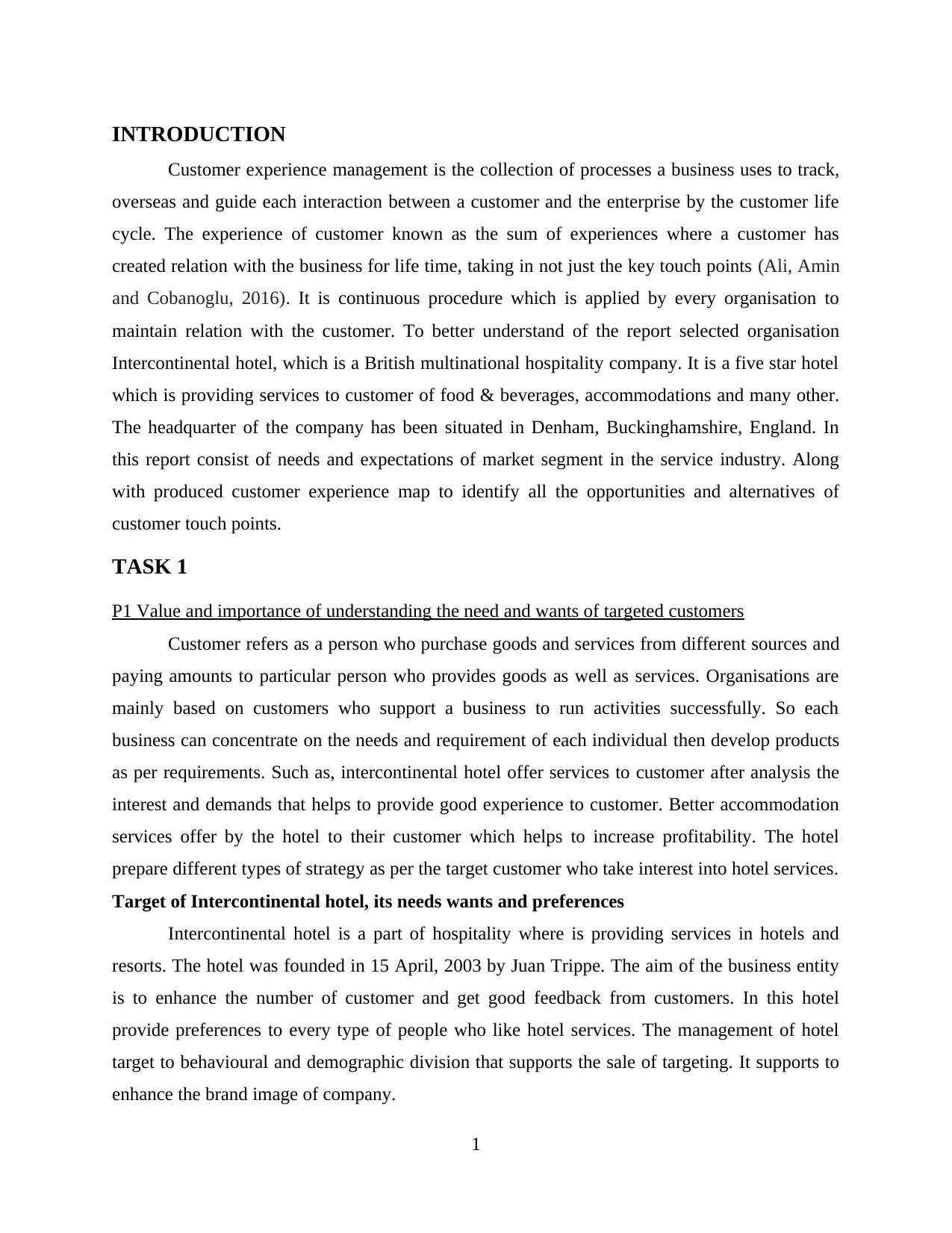
INTRODUCTION
Customer experience management is the collection of processes a business uses to track,
overseas and guide each interaction between a customer and the enterprise by the customer life
cycle. The experience of customer known as the sum of experiences where a customer has
created relation with the business for life time, taking in not just the key touch points (Ali, Amin
and Cobanoglu, 2016). It is continuous procedure which is applied by every organisation to
maintain relation with the customer. To better understand of the report selected organisation
Intercontinental hotel, which is a British multinational hospitality company. It is a five star hotel
which is providing services to customer of food & beverages, accommodations and many other.
The headquarter of the company has been situated in Denham, Buckinghamshire, England. In
this report consist of needs and expectations of market segment in the service industry. Along
with produced customer experience map to identify all the opportunities and alternatives of
customer touch points.
TASK 1
P1 Value and importance of understanding the need and wants of targeted customers
Customer refers as a person who purchase goods and services from different sources and
paying amounts to particular person who provides goods as well as services. Organisations are
mainly based on customers who support a business to run activities successfully. So each
business can concentrate on the needs and requirement of each individual then develop products
as per requirements. Such as, intercontinental hotel offer services to customer after analysis the
interest and demands that helps to provide good experience to customer. Better accommodation
services offer by the hotel to their customer which helps to increase profitability. The hotel
prepare different types of strategy as per the target customer who take interest into hotel services.
Target of Intercontinental hotel, its needs wants and preferences
Intercontinental hotel is a part of hospitality where is providing services in hotels and
resorts. The hotel was founded in 15 April, 2003 by Juan Trippe. The aim of the business entity
is to enhance the number of customer and get good feedback from customers. In this hotel
provide preferences to every type of people who like hotel services. The management of hotel
target to behavioural and demographic division that supports the sale of targeting. It supports to
enhance the brand image of company.
1
Customer experience management is the collection of processes a business uses to track,
overseas and guide each interaction between a customer and the enterprise by the customer life
cycle. The experience of customer known as the sum of experiences where a customer has
created relation with the business for life time, taking in not just the key touch points (Ali, Amin
and Cobanoglu, 2016). It is continuous procedure which is applied by every organisation to
maintain relation with the customer. To better understand of the report selected organisation
Intercontinental hotel, which is a British multinational hospitality company. It is a five star hotel
which is providing services to customer of food & beverages, accommodations and many other.
The headquarter of the company has been situated in Denham, Buckinghamshire, England. In
this report consist of needs and expectations of market segment in the service industry. Along
with produced customer experience map to identify all the opportunities and alternatives of
customer touch points.
TASK 1
P1 Value and importance of understanding the need and wants of targeted customers
Customer refers as a person who purchase goods and services from different sources and
paying amounts to particular person who provides goods as well as services. Organisations are
mainly based on customers who support a business to run activities successfully. So each
business can concentrate on the needs and requirement of each individual then develop products
as per requirements. Such as, intercontinental hotel offer services to customer after analysis the
interest and demands that helps to provide good experience to customer. Better accommodation
services offer by the hotel to their customer which helps to increase profitability. The hotel
prepare different types of strategy as per the target customer who take interest into hotel services.
Target of Intercontinental hotel, its needs wants and preferences
Intercontinental hotel is a part of hospitality where is providing services in hotels and
resorts. The hotel was founded in 15 April, 2003 by Juan Trippe. The aim of the business entity
is to enhance the number of customer and get good feedback from customers. In this hotel
provide preferences to every type of people who like hotel services. The management of hotel
target to behavioural and demographic division that supports the sale of targeting. It supports to
enhance the brand image of company.
1
⊘ This is a preview!⊘
Do you want full access?
Subscribe today to unlock all pages.

Trusted by 1+ million students worldwide
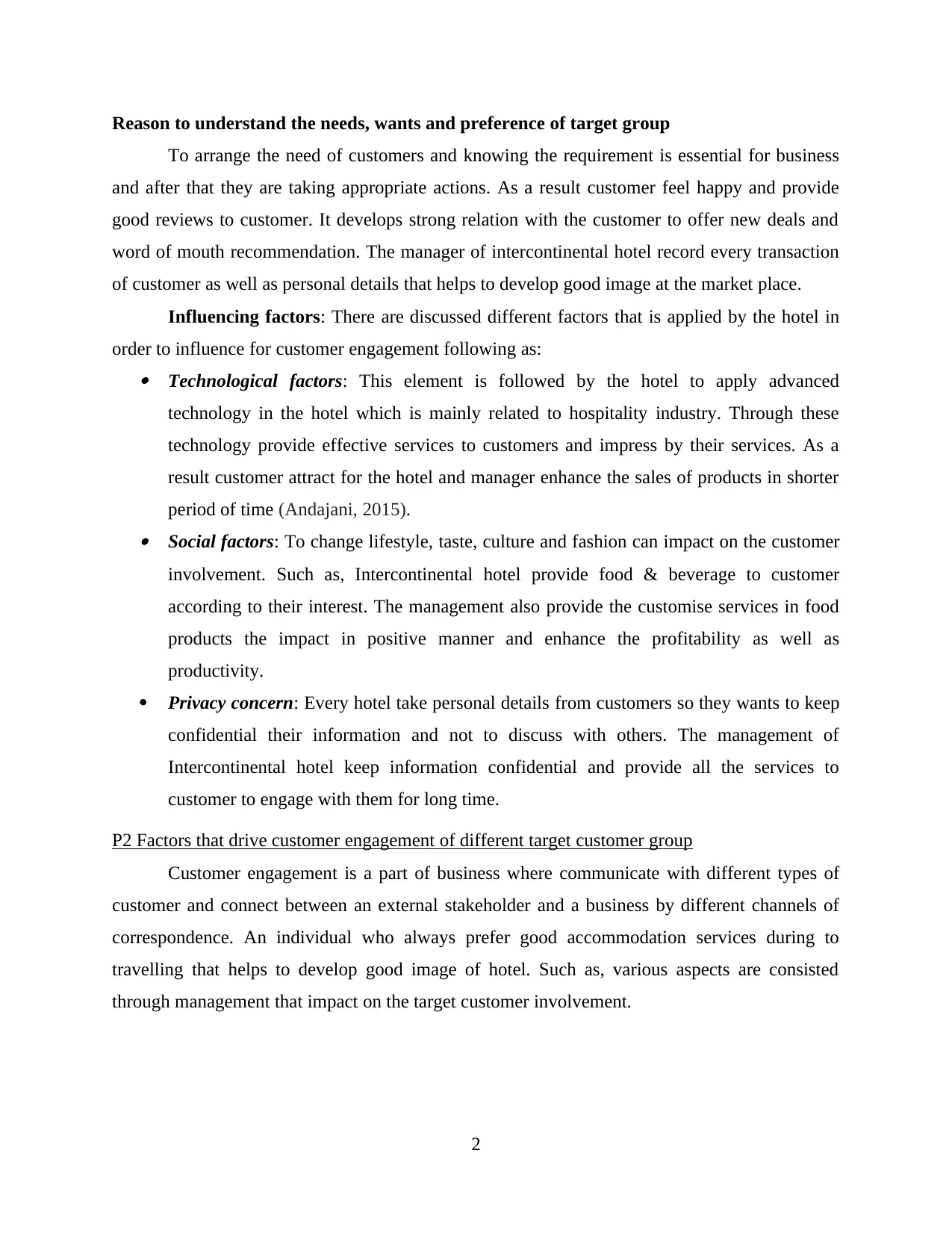
Reason to understand the needs, wants and preference of target group
To arrange the need of customers and knowing the requirement is essential for business
and after that they are taking appropriate actions. As a result customer feel happy and provide
good reviews to customer. It develops strong relation with the customer to offer new deals and
word of mouth recommendation. The manager of intercontinental hotel record every transaction
of customer as well as personal details that helps to develop good image at the market place.
Influencing factors: There are discussed different factors that is applied by the hotel in
order to influence for customer engagement following as: Technological factors: This element is followed by the hotel to apply advanced
technology in the hotel which is mainly related to hospitality industry. Through these
technology provide effective services to customers and impress by their services. As a
result customer attract for the hotel and manager enhance the sales of products in shorter
period of time (Andajani, 2015). Social factors: To change lifestyle, taste, culture and fashion can impact on the customer
involvement. Such as, Intercontinental hotel provide food & beverage to customer
according to their interest. The management also provide the customise services in food
products the impact in positive manner and enhance the profitability as well as
productivity.
Privacy concern: Every hotel take personal details from customers so they wants to keep
confidential their information and not to discuss with others. The management of
Intercontinental hotel keep information confidential and provide all the services to
customer to engage with them for long time.
P2 Factors that drive customer engagement of different target customer group
Customer engagement is a part of business where communicate with different types of
customer and connect between an external stakeholder and a business by different channels of
correspondence. An individual who always prefer good accommodation services during to
travelling that helps to develop good image of hotel. Such as, various aspects are consisted
through management that impact on the target customer involvement.
2
To arrange the need of customers and knowing the requirement is essential for business
and after that they are taking appropriate actions. As a result customer feel happy and provide
good reviews to customer. It develops strong relation with the customer to offer new deals and
word of mouth recommendation. The manager of intercontinental hotel record every transaction
of customer as well as personal details that helps to develop good image at the market place.
Influencing factors: There are discussed different factors that is applied by the hotel in
order to influence for customer engagement following as: Technological factors: This element is followed by the hotel to apply advanced
technology in the hotel which is mainly related to hospitality industry. Through these
technology provide effective services to customers and impress by their services. As a
result customer attract for the hotel and manager enhance the sales of products in shorter
period of time (Andajani, 2015). Social factors: To change lifestyle, taste, culture and fashion can impact on the customer
involvement. Such as, Intercontinental hotel provide food & beverage to customer
according to their interest. The management also provide the customise services in food
products the impact in positive manner and enhance the profitability as well as
productivity.
Privacy concern: Every hotel take personal details from customers so they wants to keep
confidential their information and not to discuss with others. The management of
Intercontinental hotel keep information confidential and provide all the services to
customer to engage with them for long time.
P2 Factors that drive customer engagement of different target customer group
Customer engagement is a part of business where communicate with different types of
customer and connect between an external stakeholder and a business by different channels of
correspondence. An individual who always prefer good accommodation services during to
travelling that helps to develop good image of hotel. Such as, various aspects are consisted
through management that impact on the target customer involvement.
2
Paraphrase This Document
Need a fresh take? Get an instant paraphrase of this document with our AI Paraphraser
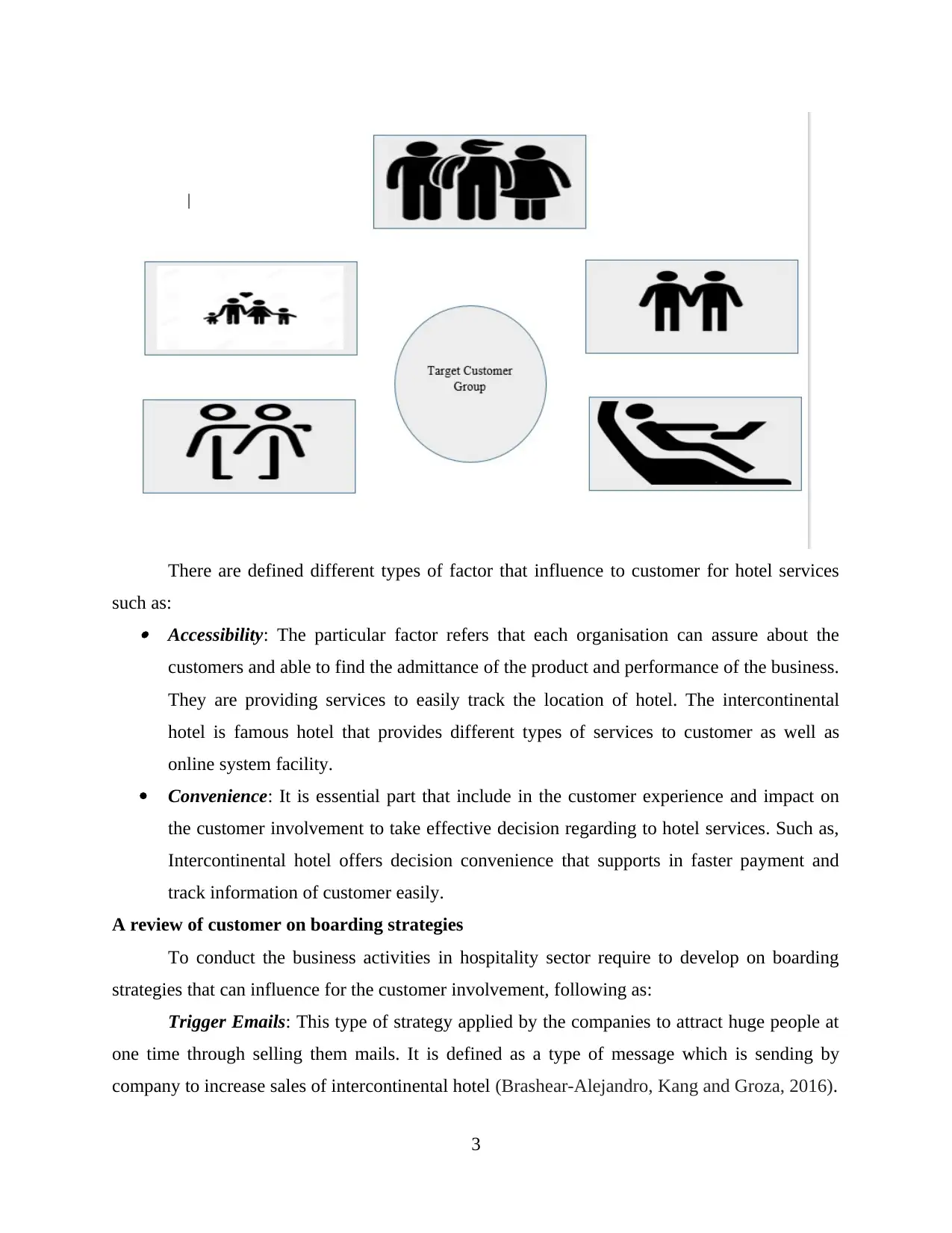
There are defined different types of factor that influence to customer for hotel services
such as: Accessibility: The particular factor refers that each organisation can assure about the
customers and able to find the admittance of the product and performance of the business.
They are providing services to easily track the location of hotel. The intercontinental
hotel is famous hotel that provides different types of services to customer as well as
online system facility.
Convenience: It is essential part that include in the customer experience and impact on
the customer involvement to take effective decision regarding to hotel services. Such as,
Intercontinental hotel offers decision convenience that supports in faster payment and
track information of customer easily.
A review of customer on boarding strategies
To conduct the business activities in hospitality sector require to develop on boarding
strategies that can influence for the customer involvement, following as:
Trigger Emails: This type of strategy applied by the companies to attract huge people at
one time through selling them mails. It is defined as a type of message which is sending by
company to increase sales of intercontinental hotel (Brashear-Alejandro, Kang and Groza, 2016).
3
such as: Accessibility: The particular factor refers that each organisation can assure about the
customers and able to find the admittance of the product and performance of the business.
They are providing services to easily track the location of hotel. The intercontinental
hotel is famous hotel that provides different types of services to customer as well as
online system facility.
Convenience: It is essential part that include in the customer experience and impact on
the customer involvement to take effective decision regarding to hotel services. Such as,
Intercontinental hotel offers decision convenience that supports in faster payment and
track information of customer easily.
A review of customer on boarding strategies
To conduct the business activities in hospitality sector require to develop on boarding
strategies that can influence for the customer involvement, following as:
Trigger Emails: This type of strategy applied by the companies to attract huge people at
one time through selling them mails. It is defined as a type of message which is sending by
company to increase sales of intercontinental hotel (Brashear-Alejandro, Kang and Groza, 2016).
3
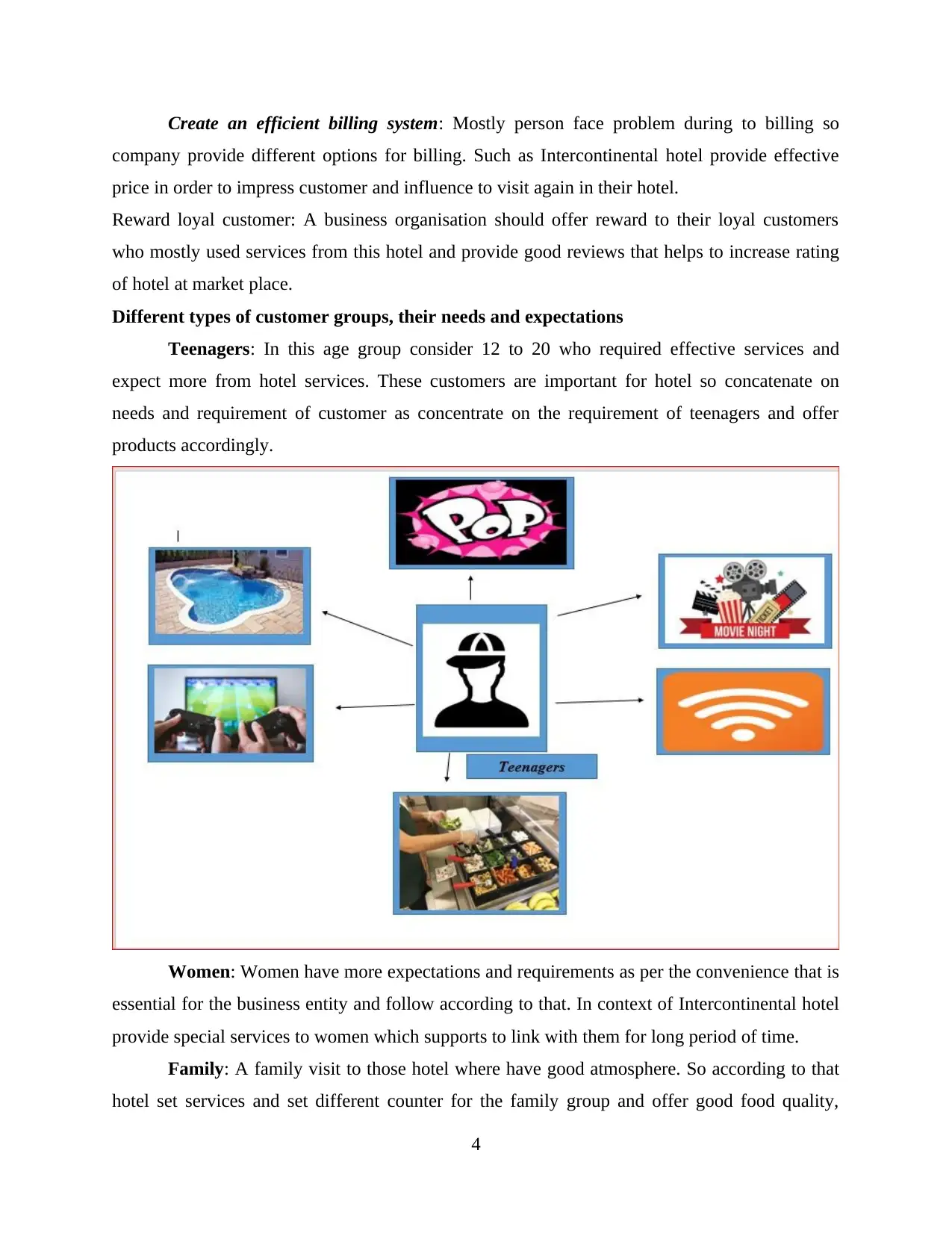
Create an efficient billing system: Mostly person face problem during to billing so
company provide different options for billing. Such as Intercontinental hotel provide effective
price in order to impress customer and influence to visit again in their hotel.
Reward loyal customer: A business organisation should offer reward to their loyal customers
who mostly used services from this hotel and provide good reviews that helps to increase rating
of hotel at market place.
Different types of customer groups, their needs and expectations
Teenagers: In this age group consider 12 to 20 who required effective services and
expect more from hotel services. These customers are important for hotel so concatenate on
needs and requirement of customer as concentrate on the requirement of teenagers and offer
products accordingly.
Women: Women have more expectations and requirements as per the convenience that is
essential for the business entity and follow according to that. In context of Intercontinental hotel
provide special services to women which supports to link with them for long period of time.
Family: A family visit to those hotel where have good atmosphere. So according to that
hotel set services and set different counter for the family group and offer good food quality,
4
company provide different options for billing. Such as Intercontinental hotel provide effective
price in order to impress customer and influence to visit again in their hotel.
Reward loyal customer: A business organisation should offer reward to their loyal customers
who mostly used services from this hotel and provide good reviews that helps to increase rating
of hotel at market place.
Different types of customer groups, their needs and expectations
Teenagers: In this age group consider 12 to 20 who required effective services and
expect more from hotel services. These customers are important for hotel so concatenate on
needs and requirement of customer as concentrate on the requirement of teenagers and offer
products accordingly.
Women: Women have more expectations and requirements as per the convenience that is
essential for the business entity and follow according to that. In context of Intercontinental hotel
provide special services to women which supports to link with them for long period of time.
Family: A family visit to those hotel where have good atmosphere. So according to that
hotel set services and set different counter for the family group and offer good food quality,
4
⊘ This is a preview!⊘
Do you want full access?
Subscribe today to unlock all pages.

Trusted by 1+ million students worldwide
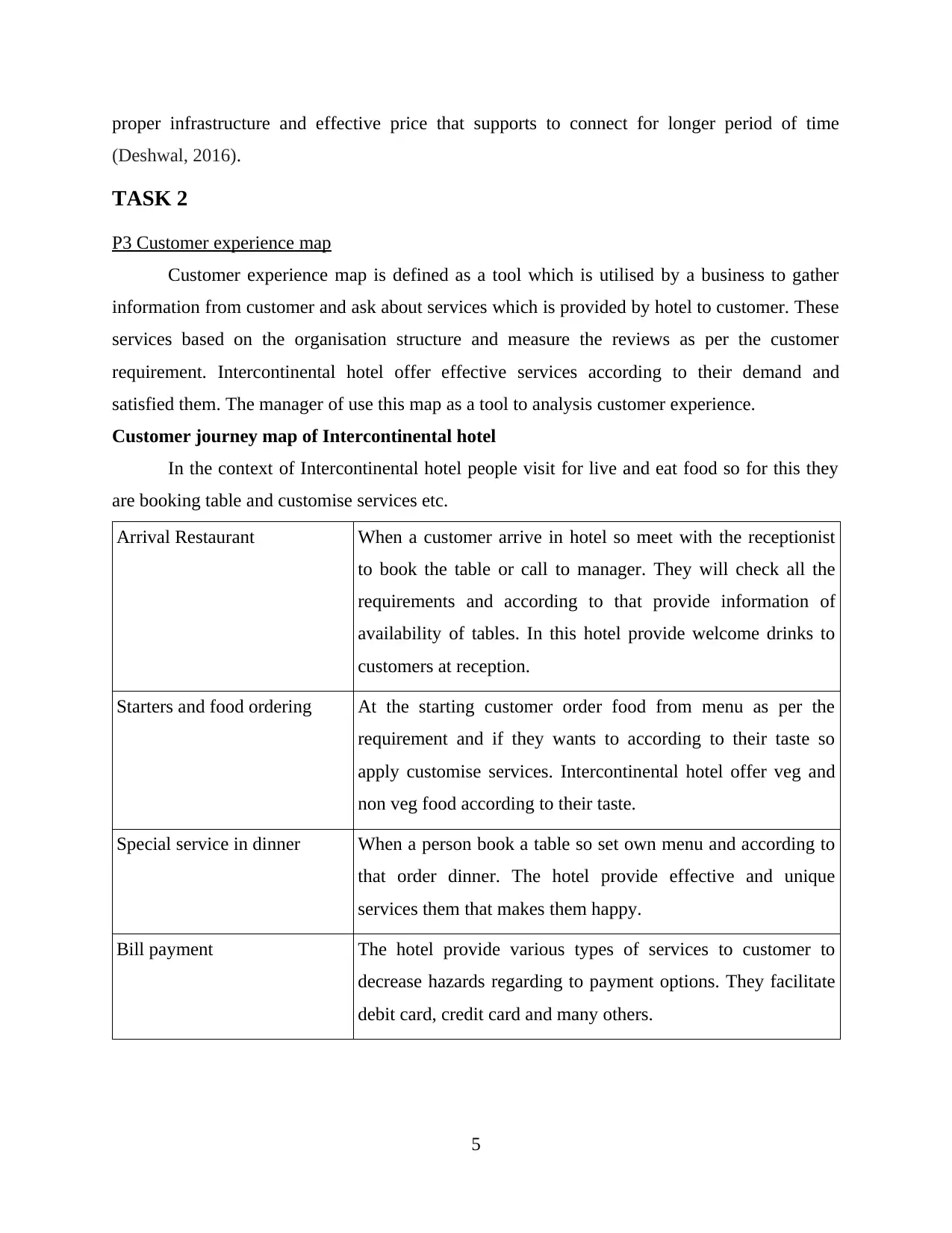
proper infrastructure and effective price that supports to connect for longer period of time
(Deshwal, 2016).
TASK 2
P3 Customer experience map
Customer experience map is defined as a tool which is utilised by a business to gather
information from customer and ask about services which is provided by hotel to customer. These
services based on the organisation structure and measure the reviews as per the customer
requirement. Intercontinental hotel offer effective services according to their demand and
satisfied them. The manager of use this map as a tool to analysis customer experience.
Customer journey map of Intercontinental hotel
In the context of Intercontinental hotel people visit for live and eat food so for this they
are booking table and customise services etc.
Arrival Restaurant When a customer arrive in hotel so meet with the receptionist
to book the table or call to manager. They will check all the
requirements and according to that provide information of
availability of tables. In this hotel provide welcome drinks to
customers at reception.
Starters and food ordering At the starting customer order food from menu as per the
requirement and if they wants to according to their taste so
apply customise services. Intercontinental hotel offer veg and
non veg food according to their taste.
Special service in dinner When a person book a table so set own menu and according to
that order dinner. The hotel provide effective and unique
services them that makes them happy.
Bill payment The hotel provide various types of services to customer to
decrease hazards regarding to payment options. They facilitate
debit card, credit card and many others.
5
(Deshwal, 2016).
TASK 2
P3 Customer experience map
Customer experience map is defined as a tool which is utilised by a business to gather
information from customer and ask about services which is provided by hotel to customer. These
services based on the organisation structure and measure the reviews as per the customer
requirement. Intercontinental hotel offer effective services according to their demand and
satisfied them. The manager of use this map as a tool to analysis customer experience.
Customer journey map of Intercontinental hotel
In the context of Intercontinental hotel people visit for live and eat food so for this they
are booking table and customise services etc.
Arrival Restaurant When a customer arrive in hotel so meet with the receptionist
to book the table or call to manager. They will check all the
requirements and according to that provide information of
availability of tables. In this hotel provide welcome drinks to
customers at reception.
Starters and food ordering At the starting customer order food from menu as per the
requirement and if they wants to according to their taste so
apply customise services. Intercontinental hotel offer veg and
non veg food according to their taste.
Special service in dinner When a person book a table so set own menu and according to
that order dinner. The hotel provide effective and unique
services them that makes them happy.
Bill payment The hotel provide various types of services to customer to
decrease hazards regarding to payment options. They facilitate
debit card, credit card and many others.
5
Paraphrase This Document
Need a fresh take? Get an instant paraphrase of this document with our AI Paraphraser
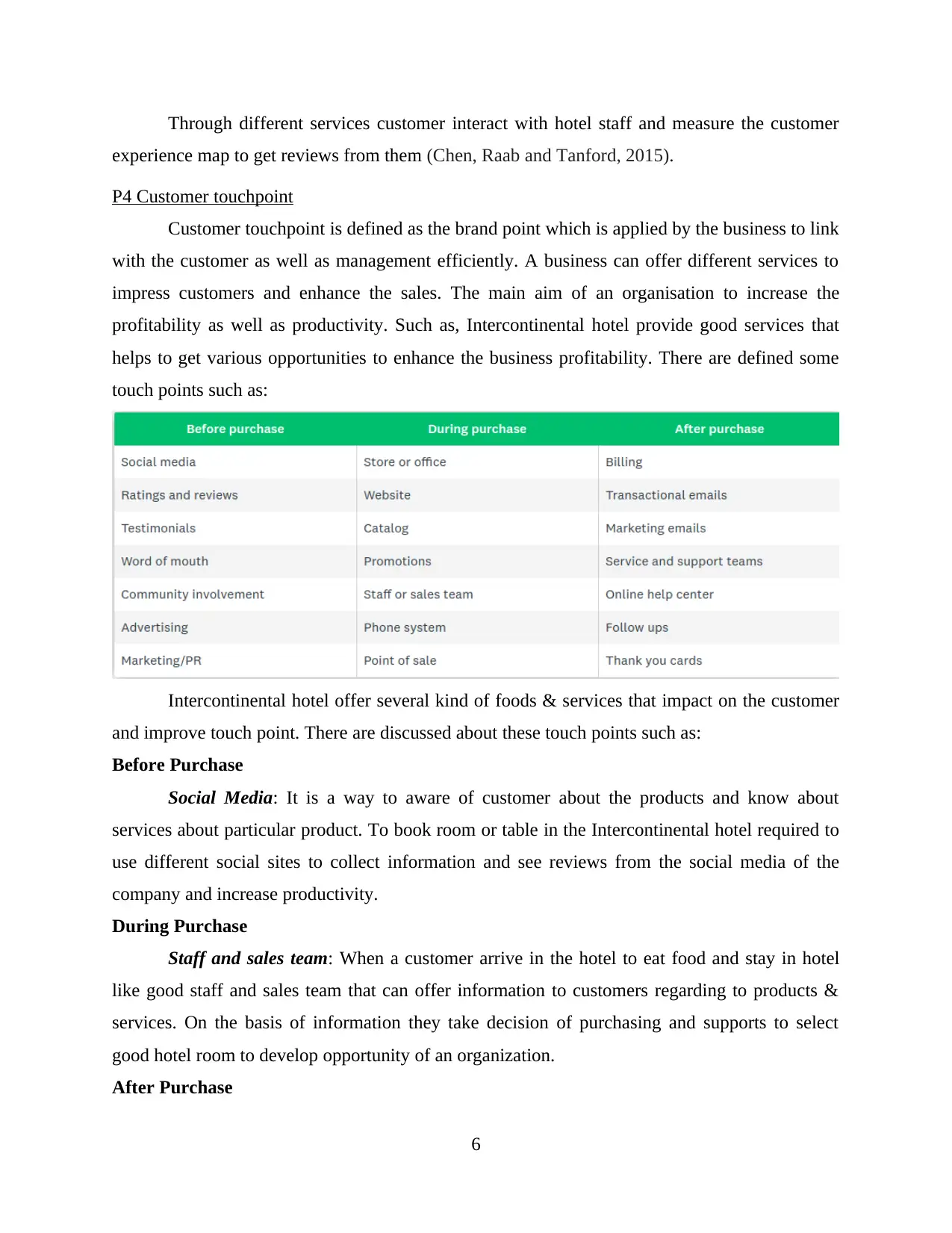
Through different services customer interact with hotel staff and measure the customer
experience map to get reviews from them (Chen, Raab and Tanford, 2015).
P4 Customer touchpoint
Customer touchpoint is defined as the brand point which is applied by the business to link
with the customer as well as management efficiently. A business can offer different services to
impress customers and enhance the sales. The main aim of an organisation to increase the
profitability as well as productivity. Such as, Intercontinental hotel provide good services that
helps to get various opportunities to enhance the business profitability. There are defined some
touch points such as:
Intercontinental hotel offer several kind of foods & services that impact on the customer
and improve touch point. There are discussed about these touch points such as:
Before Purchase
Social Media: It is a way to aware of customer about the products and know about
services about particular product. To book room or table in the Intercontinental hotel required to
use different social sites to collect information and see reviews from the social media of the
company and increase productivity.
During Purchase
Staff and sales team: When a customer arrive in the hotel to eat food and stay in hotel
like good staff and sales team that can offer information to customers regarding to products &
services. On the basis of information they take decision of purchasing and supports to select
good hotel room to develop opportunity of an organization.
After Purchase
6
experience map to get reviews from them (Chen, Raab and Tanford, 2015).
P4 Customer touchpoint
Customer touchpoint is defined as the brand point which is applied by the business to link
with the customer as well as management efficiently. A business can offer different services to
impress customers and enhance the sales. The main aim of an organisation to increase the
profitability as well as productivity. Such as, Intercontinental hotel provide good services that
helps to get various opportunities to enhance the business profitability. There are defined some
touch points such as:
Intercontinental hotel offer several kind of foods & services that impact on the customer
and improve touch point. There are discussed about these touch points such as:
Before Purchase
Social Media: It is a way to aware of customer about the products and know about
services about particular product. To book room or table in the Intercontinental hotel required to
use different social sites to collect information and see reviews from the social media of the
company and increase productivity.
During Purchase
Staff and sales team: When a customer arrive in the hotel to eat food and stay in hotel
like good staff and sales team that can offer information to customers regarding to products &
services. On the basis of information they take decision of purchasing and supports to select
good hotel room to develop opportunity of an organization.
After Purchase
6
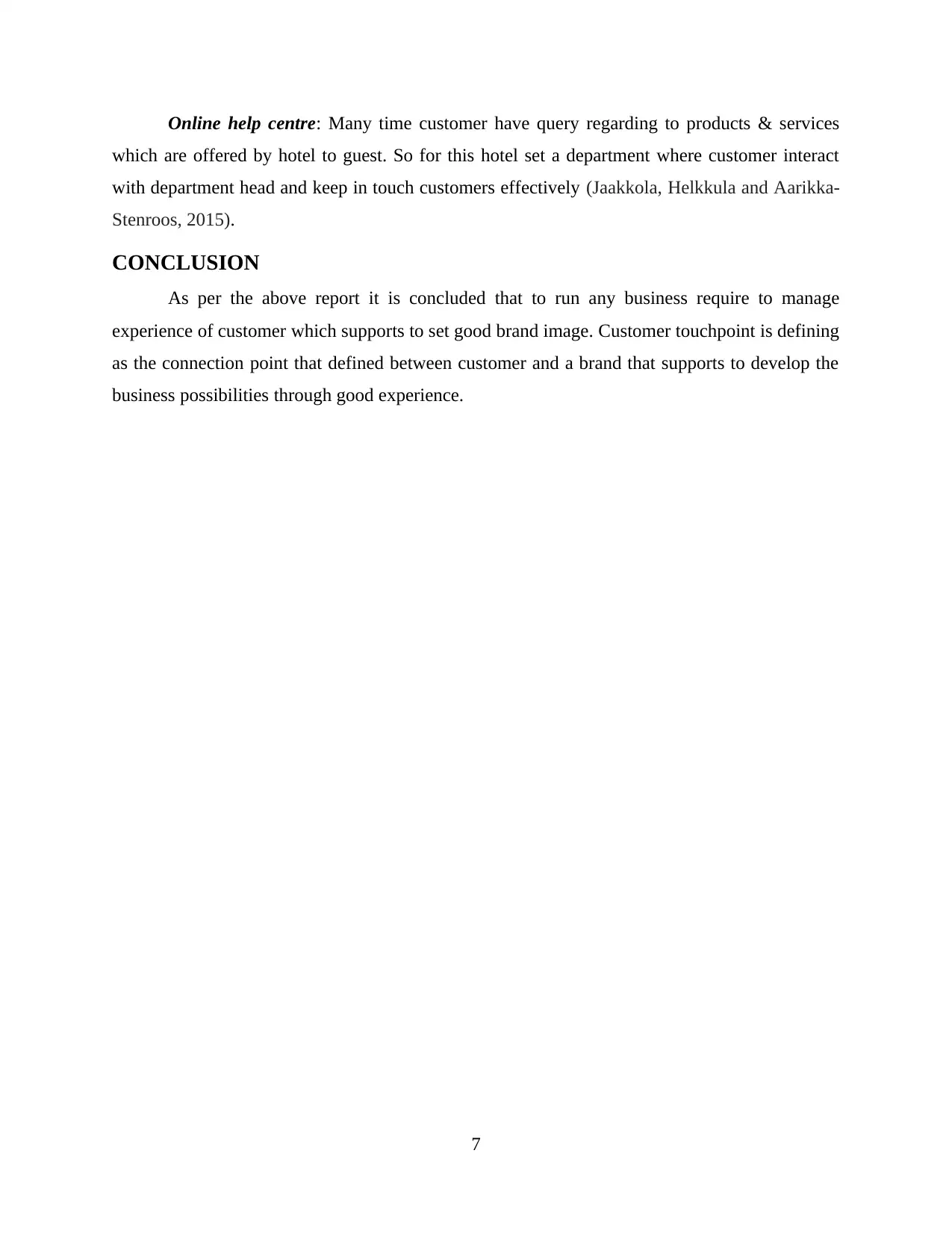
Online help centre: Many time customer have query regarding to products & services
which are offered by hotel to guest. So for this hotel set a department where customer interact
with department head and keep in touch customers effectively (Jaakkola, Helkkula and Aarikka-
Stenroos, 2015).
CONCLUSION
As per the above report it is concluded that to run any business require to manage
experience of customer which supports to set good brand image. Customer touchpoint is defining
as the connection point that defined between customer and a brand that supports to develop the
business possibilities through good experience.
7
which are offered by hotel to guest. So for this hotel set a department where customer interact
with department head and keep in touch customers effectively (Jaakkola, Helkkula and Aarikka-
Stenroos, 2015).
CONCLUSION
As per the above report it is concluded that to run any business require to manage
experience of customer which supports to set good brand image. Customer touchpoint is defining
as the connection point that defined between customer and a brand that supports to develop the
business possibilities through good experience.
7
⊘ This is a preview!⊘
Do you want full access?
Subscribe today to unlock all pages.

Trusted by 1+ million students worldwide
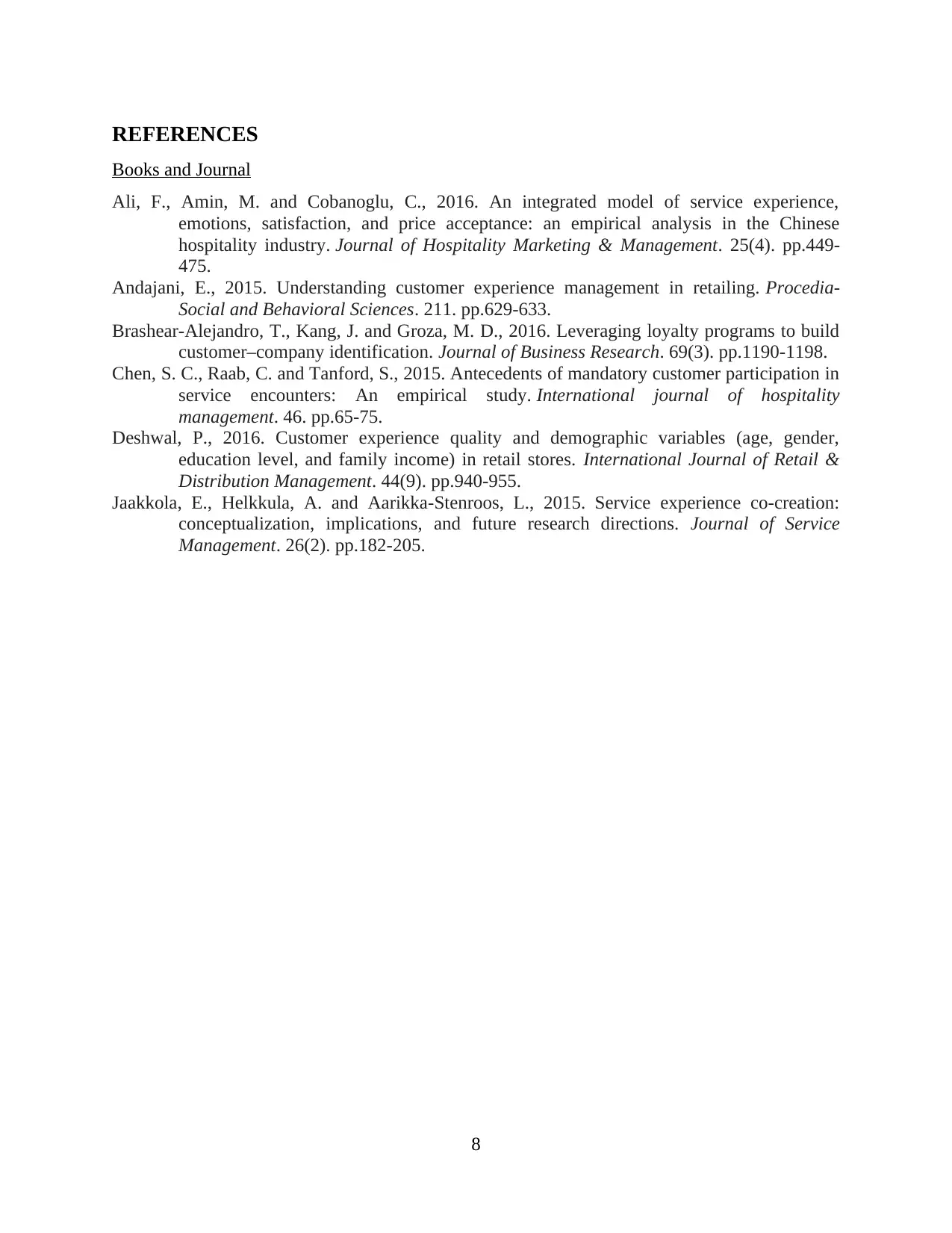
REFERENCES
Books and Journal
Ali, F., Amin, M. and Cobanoglu, C., 2016. An integrated model of service experience,
emotions, satisfaction, and price acceptance: an empirical analysis in the Chinese
hospitality industry. Journal of Hospitality Marketing & Management. 25(4). pp.449-
475.
Andajani, E., 2015. Understanding customer experience management in retailing. Procedia-
Social and Behavioral Sciences. 211. pp.629-633.
Brashear-Alejandro, T., Kang, J. and Groza, M. D., 2016. Leveraging loyalty programs to build
customer–company identification. Journal of Business Research. 69(3). pp.1190-1198.
Chen, S. C., Raab, C. and Tanford, S., 2015. Antecedents of mandatory customer participation in
service encounters: An empirical study. International journal of hospitality
management. 46. pp.65-75.
Deshwal, P., 2016. Customer experience quality and demographic variables (age, gender,
education level, and family income) in retail stores. International Journal of Retail &
Distribution Management. 44(9). pp.940-955.
Jaakkola, E., Helkkula, A. and Aarikka-Stenroos, L., 2015. Service experience co-creation:
conceptualization, implications, and future research directions. Journal of Service
Management. 26(2). pp.182-205.
8
Books and Journal
Ali, F., Amin, M. and Cobanoglu, C., 2016. An integrated model of service experience,
emotions, satisfaction, and price acceptance: an empirical analysis in the Chinese
hospitality industry. Journal of Hospitality Marketing & Management. 25(4). pp.449-
475.
Andajani, E., 2015. Understanding customer experience management in retailing. Procedia-
Social and Behavioral Sciences. 211. pp.629-633.
Brashear-Alejandro, T., Kang, J. and Groza, M. D., 2016. Leveraging loyalty programs to build
customer–company identification. Journal of Business Research. 69(3). pp.1190-1198.
Chen, S. C., Raab, C. and Tanford, S., 2015. Antecedents of mandatory customer participation in
service encounters: An empirical study. International journal of hospitality
management. 46. pp.65-75.
Deshwal, P., 2016. Customer experience quality and demographic variables (age, gender,
education level, and family income) in retail stores. International Journal of Retail &
Distribution Management. 44(9). pp.940-955.
Jaakkola, E., Helkkula, A. and Aarikka-Stenroos, L., 2015. Service experience co-creation:
conceptualization, implications, and future research directions. Journal of Service
Management. 26(2). pp.182-205.
8
1 out of 10
Related Documents
Your All-in-One AI-Powered Toolkit for Academic Success.
+13062052269
info@desklib.com
Available 24*7 on WhatsApp / Email
![[object Object]](/_next/static/media/star-bottom.7253800d.svg)
Unlock your academic potential
Copyright © 2020–2025 A2Z Services. All Rights Reserved. Developed and managed by ZUCOL.





